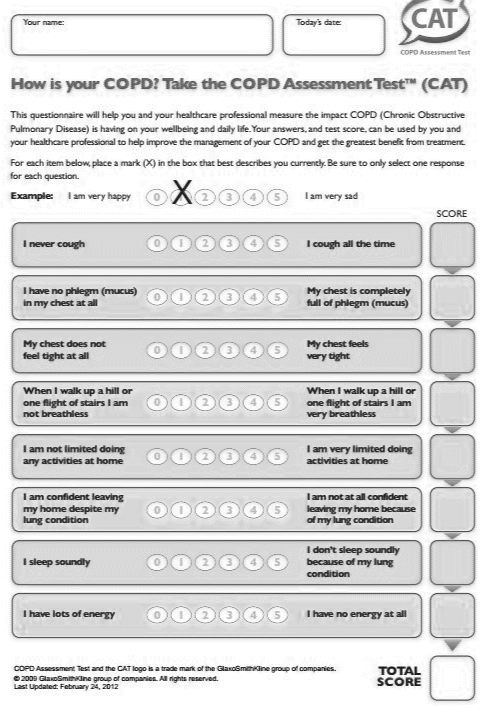If you’ve been diagnosed with chronic obstructive pulmonary disease (COPD), you and your doctor can use the COPD Assessment Test (CAT)* as one of the tools to follow your disease.
St. George’s Respiratory Questionnaire is another instrument that is very well validated be used to follow COPD. However, it is much longer and more complex the CAT.**
You can complete the CAT when you visit your doctor for a problem or symptom related to your COPD.***
The CAT has 8 questions. Each question is assigned a value of from zero to five. And the score of each question is added so that scores can range from 0 to 40.
You can take the test online or print out a pdf copy of the test.*
How to Interpret the CAT:***
CAT Score Greater than 30
The disease has a “very high” impact on their lives. “Their condition stops them doing everything they want to do and they never have any good days. If they can manage to take a bath or shower, it takes them a long time. They cannot go out of the house for shopping or recreation, or do their housework. Often, they cannot go far from their bed or chair. They feel as if they have become an invalid.”
CAT Score Greater than 20
The disease has a “high” impact on their lives. “COPD stops them doing most things that they want to do. They are breathless walking around the home and when getting washed or dressed. They may be breathless when they talk. Their cough makes them tired and their chest symptoms disturb their sleep on most nights. They feel that exercise is not safe for them and everything they do seems too much effort. They are afraid and panic and do not feel in control of their chest problem.”
CAT Score of From 10 to 20
The disease has a “medium” impact on their lives. “COPD is one of the most important problems that they have. They have a few good days a week, but cough up sputum on most days and have one or two exacerbations a year. They are breathless on most days and usually wake up with chest tightness or wheeze. They get breathless on bending over and can only walk up a fl ight of stairs slowly. They either do their housework slowly or have to stop for rests.”
CAT Score of Less than 10
The disease has a “low” impact on their lives. “Most days are good, but COPD causes a few problems and stops people doing one or two things that they would like to do. They usually cough several days a week and get breathless when playing sports and games and when carrying heavy loads. They have to slow down or stop when walking up hills or if they hurry when walking on level ground. They get exhausted easily.”
A score of 5 is the “upper limit of normal in healthy non-smokers.
Using the COPD Assessment Test to Monitor Exacerbations of COPD***
Patients with moderate-to-severe exacerbations are approximately 5 units higher than in patients with stable COPD. Patients who experience a response to treatment of their acute exacerbation had a decline in their score of 2 units at 14 days while those with no response had no change in their scores. Patients can take 2 to 3 months following an acute exacerbation to get back to their baseline CAT score. And some patients never return to their pre-exacerbation baseline score.
Upcoming posts will go over the diagnosis and therapy of COPD.
*COPD Assessment Test at https://www.catestonline.org/
**St. George’s Respiratory Questionaire at https://www.thoracic.org/assemblies/srn/questionaires/sgrq.php
***COPD Assessment Test Brochure for Healthcare Professionals at https://www.catestonline.org/images/UserGuides/CATHCPUser%20guideEn.pdf





